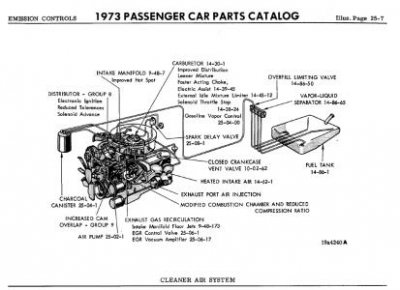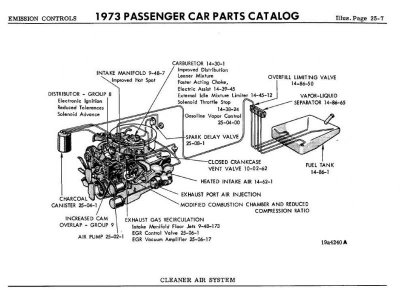You are using an out of date browser. It may not display this or other websites correctly.
You should upgrade or use an alternative browser.
You should upgrade or use an alternative browser.
Fuel vapor separator..is it nessecary?
- Thread starter Notaclue
- Start date
bigmanjbmopar
Newb with a view
No you don't need it for your car to run but if you want to be correct it should be there. What year and car is it?
idrivemopar
Well-Known Member
You could end up with vapor lock or over pressurization of your fuel tank if you don't have one, and you plug the holes on the tank. The vapors need to go somewhere, and with plugged holes and a tight fuel cap there is no where for vapors to go.
The vapor separator allows the vapors to be recovered in the charcoal canister and then pulled into the carb and burned while not allowing liquid fuel to escape into the vapor recovery system.
If yours is good, i.e., no holes in it, and you can hear the valve move inside it, most likely still usable. I refurbished mine by soaking it in evaporust for a couple of days to get both external and internal rust out of it, Once rust was gone, I rinsed the inside with wd40 to remove the evaporust residue and to keep it from rusting internally whilst I waited to reinstall. The outside I cleaned with brake clean, let dry, premiered and painted.
The vapor separator allows the vapors to be recovered in the charcoal canister and then pulled into the carb and burned while not allowing liquid fuel to escape into the vapor recovery system.
If yours is good, i.e., no holes in it, and you can hear the valve move inside it, most likely still usable. I refurbished mine by soaking it in evaporust for a couple of days to get both external and internal rust out of it, Once rust was gone, I rinsed the inside with wd40 to remove the evaporust residue and to keep it from rusting internally whilst I waited to reinstall. The outside I cleaned with brake clean, let dry, premiered and painted.
Notaclue
Member
It's a 73 rr clone (satellite) with a 318 bored and stroked. I have a Holley blue electric fuel pump I'm getting ready to put on and I want to make sure the fuel system is good to go. I don't have the canister that goes with it but I have a separator off of a dodge polara that I can use if need be.
Last edited:
Notaclue
Member
I have a vented fuel cap, is that enough to make sure vapor lock doesn't occur? If not what can I do? Anybody have a diagram by chance?
- - - Updated - - -
Can I just run a small hose to a point above the tank with either a filter or relief valve on it?
- - - Updated - - -
Can I just run a small hose to a point above the tank with either a filter or relief valve on it?
- Local time
- 12:27 PM
- Joined
- Nov 20, 2013
- Messages
- 1,509
- Reaction score
- 294
- Location
- Ft Lauderdale fla.
Vapor lock is when the fuel gets hot... not really the same... I would keep the can and block off the carb vent by putting them together at the can. With out it you can pull a vacuum with the fuel pump or get dirt in the tank from an open line.... I was considering putting one on my 67 because it only has a vent in the cap and moisture gets in and the can filters it out some
- - - Updated - - -
Yes just keep it all out side the car.... it will smell of fuel and in extreme temp changes may drip fuel but that will replace the can.
- - - Updated - - -
I have a vented fuel cap, is that enough to make sure vapor lock doesn't occur? If not what can I do? Anybody have a diagram by chance?
- - - Updated - - -
Can I just run a small hose to a point above the tank with either a filter or relief valve on it?
Yes just keep it all out side the car.... it will smell of fuel and in extreme temp changes may drip fuel but that will replace the can.
idrivemopar
Well-Known Member
Vented fuel caps and original style caps with pressure safety valves only work when the tank is less then full, otherwise the fuel blocks vapor from escaping through the filler tube.
Just a word of advice, when it comes to safety systems or fuel related systems, circumventing the original engineering for the system unless its improving the system is not always a good idea, and just wanted to say, and not trying to knock others advice on the board, but know what outcome of doing so before making changes that are not to specification and could create other unanticipated issues.
I'm a stickler as some of you know for doing things properly.
- - - Updated - - -
I would not recommend this at all, three reasons, one, you may end up with fumes in the trunk or cabin of the car and breathing fuel vapor is hazardous, two, a trunk or cabin with fumes and a spark, not a good thing. and three, venting vapor next to the exhaust is trouble just waiting to happen, especially if you get a back fire and have an exhaust leak, then you might have some more serious problems.
Just a word of advice, when it comes to safety systems or fuel related systems, circumventing the original engineering for the system unless its improving the system is not always a good idea, and just wanted to say, and not trying to knock others advice on the board, but know what outcome of doing so before making changes that are not to specification and could create other unanticipated issues.
I'm a stickler as some of you know for doing things properly.
- - - Updated - - -
- - - Updated - - -
Can I just run a small hose to a point above the tank with either a filter or relief valve on it?
I would not recommend this at all, three reasons, one, you may end up with fumes in the trunk or cabin of the car and breathing fuel vapor is hazardous, two, a trunk or cabin with fumes and a spark, not a good thing. and three, venting vapor next to the exhaust is trouble just waiting to happen, especially if you get a back fire and have an exhaust leak, then you might have some more serious problems.
Notaclue
Member
Picked up an inline fuel filter and some tubing earlier, going to make a vent to sit above the tank near the rear of the car if I can't get the separator working. Going to do some more research on the subject first. Hope to hear more opinions on this subject though. Thanks again all.
Notaclue
Member
I think a more prudent thing to ask at this point is whether or not it's a better idea to have some kind of vent routed outside of harms way rather than hooking up the separator which just runs in the engine compartment without a canister
Dr HEMI
Member
Where does the vent line from the fuel vapor separator terminate at the rear?
I have added the vapor separator but it is on a '70 with no canister or recovery
system. It does not go to the tank vent? I can't find a diagram anywhere.
I have added the vapor separator but it is on a '70 with no canister or recovery
system. It does not go to the tank vent? I can't find a diagram anywhere.
Kernel Sanders
Well-Known Member
- Local time
- 12:27 PM
- Joined
- Dec 13, 2008
- Messages
- 820
- Reaction score
- 244
- Location
- Ottawa, Ontario, Canada
Dr HEMI
Member
Wow! Thanks!!! Not exactly what I needed though.
I have the vapor seperator canister by the fuel pump with one line running to the back.
I have the vapor seperator canister by the fuel pump with one line running to the back.
67 coronet
Well-Known Member
that will work fine.have done several sealed fuel cell vents like that with no prob.recirculating the fuel venting to be burnt by the eng was the beginings of modern smog devises.if venting to the outside rear was a problem my 67 would have blown up a long time ago since it just vents out the cap.Picked up an inline fuel filter and some tubing earlier, going to make a vent to sit above the tank near the rear of the car if I can't get the separator working. Going to do some more research on the subject first. Hope to hear more opinions on this subject though. Thanks again all.
Similar threads
- Replies
- 5
- Views
- 717


















